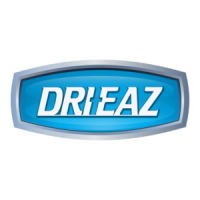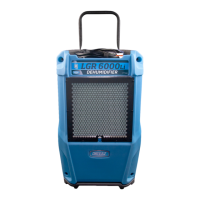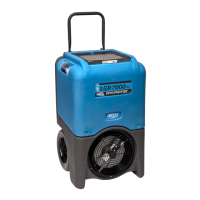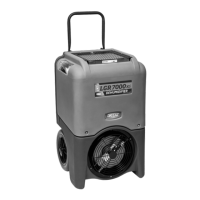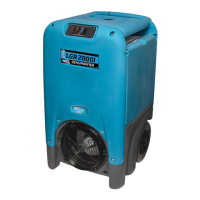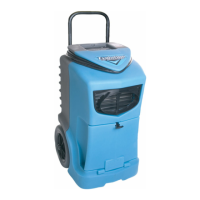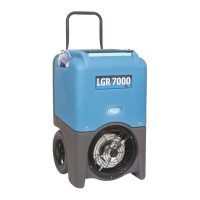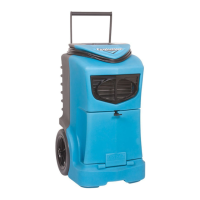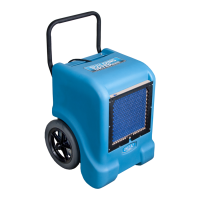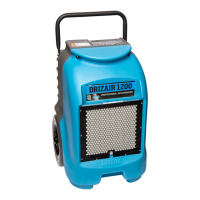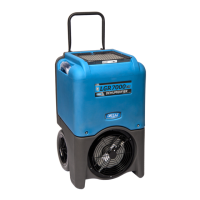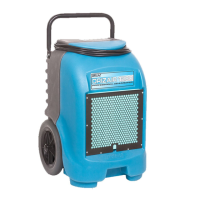07-01674F 2011-04 Warranty 07-00420 1 Dri-Eaz Products, Inc.
Owner’s Manual
LGR 2800i Portable Dehumidifier (F410)
LGR 3500i Portable Dehumidifier (F411)
Featuring integrated sensors and remote monitoring capability
DRI-EAZ PRODUCTS, INC.
15180 Josh Wilson Road, Burlington, WA 98233
Phone: 800-932-3030 Fax: 360-757-7950 www.dri-eaz.com
The Dri-Eaz® LGR i-Series dehumidifiers reduce humidity in enclosed structural
environments by removing water vapor from the air. The i-Series product line is engineered
to be rugged, durable and highly portable, making them ideally suited for water damage
restoration, structural drying, construction, and other applications requiring temporary,
high-performance dehumidification.
Product may be covered by: U.S. Patent Pending 12/272,455; 12/558,389; 12/767,526
READ AND SAVE THESE INSTRUCTIONS
SAFETY INSTRUCTIONS
WARNING! Electric shock hazard, rotating fan, hot
surface hazards. Unplug unit before opening cover
for cleaning or servicing. Unit must be grounded.
• Inspect the power cord before use. If cord is
damaged, do not use. Always grasp the plug (not
the cord) to unplug.
• Insert three-prong plug on power cord into a
matching electrically grounded outlet. Do not use
adapter. Never cut off third prong. Do not use an
extension cord.
• The unit must be operated on a 115V/60 Hz circuit
protected by a Ground Fault Circuit Interrupter
(GFCI) device.
• Keep motor and wiring dry.
• Do not attempt to repair the unit. For Authorized
Service Centers, call Dri–Eaz at 800-932-3030.
BEFORE YOU BEGIN
Unpacking your unit
Retain all packing material and boxes for possible
equipment returns. Find and retain the AA batteries,
which must be installed before using the unit.
Installing the sensor batteries
Two AA batteries are shipped with the 2800i and 3500i
to provide power to the built-in HygroTrac® wireless
transmitter when the unit is not connected to AC power.
The battery compartment is located directly under the
power cord socket on the back of the unit (see Figure C).
Use a flat-blade screwdriver to turn the battery
compartment cover 90° counter-clockwise and remove
the cover. Insert the batteries with the negative terminal
in first. After inserting the batteries, secure the cover by
pressing it in with the screwdriver and turning it 90°
clockwise.
Warranty registration
Visit warranty.drieaz.com to register your purchase.
Registration allows us to better assist you with using,
maintaining or servicing your equipment, as well as to
contact you in case we have important safety information
concerning your Dri-Eaz product. If you determine
service is required, have your equipment model, serial
number and original proof of purchase available and call
your distributor for assistance with obtaining a return
material authorization (RMA).
IMPORTANT
To help prevent drip tray overflow after using the dehumidifier, always purge the unit before moving.
1. Turn the unit off and allow the plugged in dehumidifier to rest for 10 minutes.
2. Press the
PURGE key and while the purge pump is operating, tip the unit back approximately 45° and hold the
unit in place until the purge cycle is complete. The manual purge cycle lasts approximately 10 seconds.
3. Return the unit to the upright position and press PURGE one more time to empty the pump.
Remove the dehumidifier promptly from the job site once these steps have been completed.


